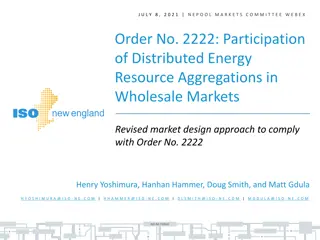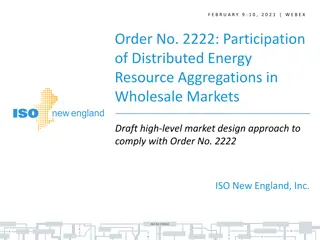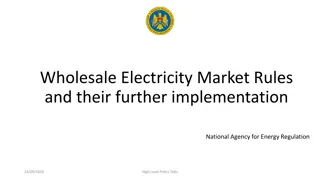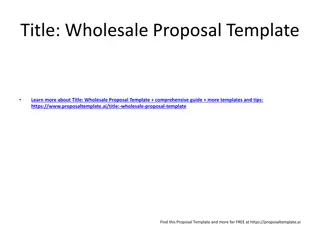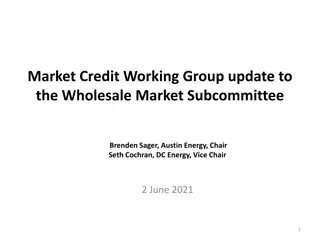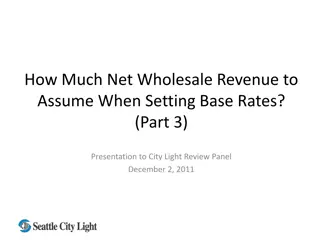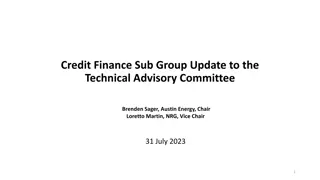Wholesale Market Credit Update Summary
Summary of recent updates from the Market Credit Working Group to the Wholesale Market Subcommittee, including discussions on various NPRRs, ERCOT credit considerations, and default allocation practices in ISO/RTO markets.
Download Presentation

Please find below an Image/Link to download the presentation.
The content on the website is provided AS IS for your information and personal use only. It may not be sold, licensed, or shared on other websites without obtaining consent from the author.If you encounter any issues during the download, it is possible that the publisher has removed the file from their server.
You are allowed to download the files provided on this website for personal or commercial use, subject to the condition that they are used lawfully. All files are the property of their respective owners.
The content on the website is provided AS IS for your information and personal use only. It may not be sold, licensed, or shared on other websites without obtaining consent from the author.
E N D
Presentation Transcript
Market Credit Working Group update to the Wholesale Market Subcommittee Brenden Sager, Austin Energy, Chair Seth Cochran, DC Energy, Vice Chair 6 October 2021 1
MCWG update to WMS General Update 21 Sept 2021 Joint MCWG/CWG WEBEX Meeting 5 NPRRs reviewed for their credit impacts All considered having no credit impacts 1082NPRR Emergency Response Service (ERS) Test Exception for Co-located ERS Loads. 1087NPRR Prohibit Participation of Critical Loads and Generation Resource Support Loads as Load Resources or ERS Resources. 1090NPRR ERS Winter Storm Uri Lessons Learned Changes and Other ERS Items. 1093NPRR Load Resource Participation in Non-Spinning Reserve. 1094NPRR Allow Under Frequency Relay Load to be Manually Shed During EEA3. 2
MCWG update to WMS Review NPRR 1088 Elimination of RFAF, submitted by Grand Oak Capital Partners, LP Elimination of Real-Time Forward Adjustment Factor (RFAF) and the Day-Ahead Forward Adjustment Factor (DFAF) from being applied to prior market positions and instead applies the RFAF and DFAF to ongoing market positions MCWG continues to discuss this but unlikely to support complete elimination of FAF s ERCOT Credit not in favor of complete elimination May tweak rules around trader-only CP s but retain rules around LSE s 3
ISO/RTO Default Allocation Practices ISO/RTO Default Allocation Practices ERCOT MISO SPP CAISO PJM Activity base used in default allocation: Based on previous month Max activity buckets: Based on invoice activity during the same period of time as the unpaid invoice(s) of the MP whose unpaid Past Due Amount has been declared an Uncollectible Obligation. Based on Invoice activity during the same period of time as the unpaid invoice(s) of the MP whose Unpaid Obligation has been declared an Uncollectible Obligation. Hybrid approach based on dollar and MW activity: Activity component is based on on last three months gross activity Based on quarterly percentage shares calculated based on quarterly average over rolling four- quarter look-back period: Default Allocation Assessment shall be equal to (0.1(1/N) + 0.9(A/Z)) -Metered -- Generation/DCT Imp -Metered Load -Bilateral sales -Bilateral purchases -DAM sales -DAM purchases -CRR Sales & ownership in DAM -CRR Auction Purchases The Uncollectible Obligation is allocated to all Non-Defaulting MPs who conducted business in the market during the time covered by the invoice(s) containing the Uncollectible Obligation(s). Allocated to each MP that had been invoiced during the same period of time as the unpaid invoice(s) of the MP whose unpaid Past Due Amount has been declared an Uncollectible Obligation. Dissection of calculation: 20% of payment default amount allocated in proportion to net amounts payable 1) % share to total number of participants weighted at 10% (not exceeding $10,000); and =% Loss for MPA = MPA Market Charges + Market Credits in weekly invoicing cycle/ MPALL (Market Charges + Market Credits) in weekly invoicing cycle. % Loss for MPA = MPA Market Charges + Market Credits in weekly invoicing cycle/MPALL (Market Charges + Market Credits) in weekly invoicing cycle 30% of payment default amount allocated in proportion to sum of absolute values of dollar amounts shown on invoices payable or receivable after certain dollar amount exclusions for GMC, RMR, and Wheeling Access Charge costs and exclusions for billing of Access Charges and payment of Transmission Revenue Requirements to Participating Transmission Owners 2) % share to total market over last 3 months weighted at 90% A = for Members comprising factor "N" above, the Member's gross activity as determined by summing the absolute values of the charges and credits for each of the Activity Line Items identified in section 15.2.2(b) below as accounted for and billed pursuant to Operating Agreement, Schedule 1, section 3 for the month of default and the two previous months. -Loss Obligation of MPA = ((% Loss for MPA) x $ Amt of Uncollectible Obligation) minus (- ) (Reduction of Payments + Pro rata share of partial payment(s)) Loss Obligation of MPA = (% Loss for MPA) x $ Amt of Uncollectible Obligation, where: MP = Market Participant -Market Charges = The absolute value of all charge amounts associated with invoices for Market Activities. -Market Credits = The absolute value of all credit amounts associated with invoices for Market Activities. -MPALL = All Market Participants other than MPs with Uncollectible Obligations. Where: -MP = Market Participant --Market Charges = The absolute value of all charge amounts associated with invoices for Market Services. -Market Credits = The absolute value of all credit amounts associated with invoices for Market Services. -MPALL = All Market Participants other than MPs with Uncollectible Obligations. -Reduction of Payment = The amount of the Unpaid Obligation originally assessed to MP -Pro rata share of partial payment(s) = Any partial payments received during cure period Z = the sum of factor A for all Members excluding ex officio Members, State Consumer Advocates , Emergency and Economic Load Response Program Special Members , and municipal electric system Members that have been granted a waiver under Operating Agreement, section 17.2. 50% of payment default amount allocated in proportion to largest of the following amounts calculated in MWh for every month in each applicable calendar quarter Cleared DA Schedules to supply Energy Metered Generation Cleared DA Schedules for demand Metered Load x 103%... The greater of the quantity of CRRs or Inter-SC Trades of Energy Default Uplift Billing Timeline no earlier than 90 days no prescribed timeline next practicable invoices
Credit Exposure Methods Concentrating approximately half of the total default risk to CRR activity is not an equitable allocation and has a negative impact on the CRR product The risk of a cascading default situation increases under an allocation that heavily concentrates uplift costs to a subset of the market Allocating half of a total default to CRR activity is not reasonable Default allocation should be spread evenly across dollar-weighted market activity o Default allocation should balance the burden of paying back discounted receivables across all dollar activity (i.e., payables and receivables), however not in a way that dramatically distorts the cash flow stream o The allocation of 50% of a $2.9B default to CRR holders who participate in a market with an average annual value < $1B [measured by market-wide auction revenue or settlement] is unreasonable compared to the greater energy market value of ~$50B during the week of Storm Uri o No allocation will ever be perfectly fair; however, we need to reach a reasonable level 5
PJM methodology Default uplift shares calculated using gross dollar activity spreads uplift risk more evenly across all market transactions o Better represents market activity o Avoids a high concentration of allocation risk to a single product type o Using gross value avoids issues with netting where a counterparty could avoid default uplift, but yet have significant market activity and risk of default Utilizing a look back horizon of three months promotes an even assessment by avoiding peaks and valleys within settlement/invoice cycles Under PJM s tiered approach all market participants backstop a default PJM s design allocates default uplift to a single risk pool o Today s short-payment process draws from a single risk pool o Avoids potential issues with multiple risk pools With more risk pools there are fewer counterparties to backstop a massive failure, which increases the likelihood of cascading defaults Who is the ultimate backstop if a black swan event cannot be contained within a single market segment or product type? Defining and designating risk pools does not appear to be straightforward ERCOT and potentially market participants would have to manage multiple risk pools 6
MCWG update to WMS Market-wide average TPE increased from $ 704.3 million in July to $ 751.8 million in August TPE increased mainly due to Settlement disputes for ODs February 14, 2021, and February 15, 2021, included in RTM True-Up statements Includes active short pay entities Discretionary Collateral is defined as Secured Collateral in excess of TPE,CRR Locked ACL and DAM Exposure Average Discretionary Collateral decreased from $2,081.8 million to $1,917.1 million The decrease in Discretionary Collateral is largely due to increase in CRR Locked ACL and TPE No unusual collateral call activity 7




